2020-11-26 - Nº 291
Editorial
Esta é a Newsletter Nº 291 que se apresenta com o mesmo formato que as anteriores. Se gostar da Newsletter partilhe-a!
Todas as Newsletters encontram-se indexadas no link.
Esta Newsletter tem os seguintes tópicos:
Faz hoje anos que nascia, em 1810, o inventor, engenheiro e industrial inglês William George Armstrong. Ele inventou uma máquina hidroelétrica que produzia electricidade de fricção (1843), um guindaste hidráulico, um acumulador hidráulico para alimentar máquinas, a arma de carregamento da culatra Armstrong, protótipo de toda a artilharia moderna e uma arma de carregamento por culatra com cilindro de arame enrolado. Ele fundou a Elswick Engineering Works que fundiu as suas actividades de armamento e construção naval com a Vickers 'Sons and Co. para formar a Vickers Armstrong, Ltd. A sua mansão, Cragside, foi a primeira casa britânica iluminada por hidroeletricidade.
Faz também hoje anos que nascia, em 1817, o químico e educador francês Charles Adolphe Wurtz. Ele ficou conhecido pelas suas pesquisas sobre compostos orgânicos de nitrogénio, hidrocarbonetos e glicóis. Em 1848, ele estudou um grupo de compostos relacionados à amónia chamados aminas e mostrou que pertenciam a um tipo com núcleo de nitrogénio. Na amónia, um átomo de nitrogénio foi ligado a três hidrogénios, enquanto nas aminas, os radicais orgânicos substituíram um ou mais desses hidrogénios.
Faz igualmente hoje anos que nascia, em 1837, o químico inglês John Newlands. Ele foi o primeiro que estabeleceu uma ordem de elementos pelos pesos atómicos e observou uma periodicidade nas propriedades. Cada oitavo elemento tem propriedades semelhantes, por isso ele chamou a Lei das Oitavas. Demorou mais um quarto de século, e o trabalho de outros, como Dmitry Mendeleev, para que o significado de sua descoberta fosse reconhecido na tabela periódica de elementos.
Faz também hoje anos que nascia, em 1876, o Inventor norte-americano Willis Carrier. Ele deu inicio ao ar condicionado moderno. Em 1902 (um ano depois de se formar com um M.E.), ele projectou seu primeiro sistema para controlar a temperatura e a humidade numa gráfica do Brooklyn. Em 2 de Janeiro de 1906, ele patenteou um "Aparelho para tratar o ar", o primeiro equipamento de ar condicionado tipo spray do mundo, (U.S. No. 808.897). As suas “Rational Psychrometric Formulas,” (1911) permanecem essenciais para engenheiros de ar condicionado. Em 1915, ele fundou a Carrier Engineering Corporation, para lidar com as condições de temperatura e humidade no ambiente industrial. Eventualmente, a tecnologia alcançou edifícios públicos e residências. Ele desenvolveu a primeira máquina de refrigeração centrífuga de baixa pressão segura usando refrigerante não tóxico e não inflamável.
Faz igualmente hoje anos que nascia, em 1894, o matemático norte-americano Norbert Wiener. Ele estabeleceu a ciência da cibernética, um termo que ele cunhou, que se preocupa com os factores comuns de controle e comunicação em organismos vivos, máquinas automáticas e organizações. Ele alcançou renome internacional ao formular algumas das contribuições mais importantes para a matemática no século XX. O seu trabalho em análise harmónica generalizada e teoremas tauberianos ganhou o Prémio Bôcher em 1933, quando ele recebeu o prémio da American Mathematical Society pelas suas memórias Teoremas Tauberianos publicado em Annals of Mathematics no ano anterior. A sua extraordinária gama de interesses incluía processos estocásticos e teoria quântica.
Faz também hoje anos que nascia, em 1898, o químico alemão Karl Ziegler. Ele dividiu o Prémio Nobel de Química de 1963 com Giulio Natta “pelas suas descobertas no campo da química e tecnologia de altos polímeros”, melhorando a qualidade dos plásticos. As moléculas de polímero são longas cadeias de milhares de átomos, formadas pela conexão de unidades repetidas de uma pequena molécula (o monómero). Ziegler encontrou forças eléctricas peculiares numa ligação entre um átomo de alumínio e um átomo de carbono numa cadeia de hidrocarbonetos: moléculas reactivas são atraídas e ensanduichadas entre esses dois átomos, aumentando o comprimento da cadeia. Quando a cadeia é longa o suficiente, a separação do alumínio interrompe o crescimento da molécula. A combinação de compostos de alumínio com outros compostos metálicos dá catalisadores Ziegler.
Por fim, faz hoje anos que nascia, em 1940, o matemático italiano Enrico Bombieri. Ele recebeu a Medalha Fields em 1974 pelas suas principais contribuições ao estudo dos números primos, ao estudo das funções uni-valentes e à conjectura local de Bieberbach, à teoria das funções de várias variáveis complexas e à teoria da equações diferenciais e superfícies mínimas. "Teorema do valor médio de Bombieri", que diz respeito à distribuição dos primos em progressões aritméticas que se obtém pela aplicação dos métodos do crivo grande.
Faz hoje 55 anos que a França se tornou a 3ª nação a lançar um foguetão próprio um satélite artificial. O Astérix foi lançado a bordo de um foguetão Diamant a partir de Hammaguir, na Argélia. Tendo-se tornado nessa altura a 6ª nação a ter satélites artificiais a orbitar a Terra, o satélite Astérix comunicou com a Terra durante 111 dias. Devido à altitude relativamente elevada de sua órbita, não se espera que reentre na atmosfera da Terra por vários séculos.
Faz também hoje 9 anos que partia em direcção a Marte o rover Curiosity lançado num Foguetão Altas V. O Curiosity era o maior e mais poderoso veículo espacial que alguém tinha enviado ao Planeta Vermelho. O laboratório cientifico de duas toneladas tem o tamanho de um pequeno SUV. O objectivo da missão era procurar ambientes habitáveis em Marte, ou evidências de que o planeta poderia ter sido habitável no passado. A sua viagem durou cerca de 9 meses e em poucas semanas, o Curiosity cumpriu a sua missão. Ele encontrou evidências de água corrente em Marte. Mais tarde, também encontrou moléculas orgânicas em Marte.
E nesta semana que passou a China lançou uma grande nave espacial robótica do Centro de Lançamento Espacial Wenchang, na província de Hainan, no sul da China, com a tarefa de pousar na Lua e trazer amostras lunares, 44 anos depois da última vez desde que substâncias extraterrestres foram trazidas de volta à Terra. O foguetão Chang Zheng 5, o maior e mais poderoso veículo de lançamento na China, ergueu seu corpo de 20 andares e voou em direcção ao céu, arrastando uma chama prateada espectacular às 4h30 da sua plataforma de lançamento, deixando muitos espectadores dentro e ao redor do centro costeiro de Wenchang com admiração e entusiasmo enquanto o gigantesco foguetão subia em direcção ao céu. Com cerca de 57 metros de altura e cerca de 852 Mil quilos este foguetão de dois estágios tem a capacidade de transportar cerca de 9 mil quilos de carga para a órbita trans-lunar.
Na Newsletter desta semana apresentamos diversas noticias, artigos científicos assim como projetos de maker. É apresentada a revista MagPi nº100 de Dezembro e a revista newelectronics de 24 de Novembro.
 João Alves ([email protected])
João Alves ([email protected])
O conteúdo da Newsletter encontra-se sob a licença  Creative Commons Attribution-NonCommercial-ShareAlike 4.0 International License.
Creative Commons Attribution-NonCommercial-ShareAlike 4.0 International License.
Novidades da Semana
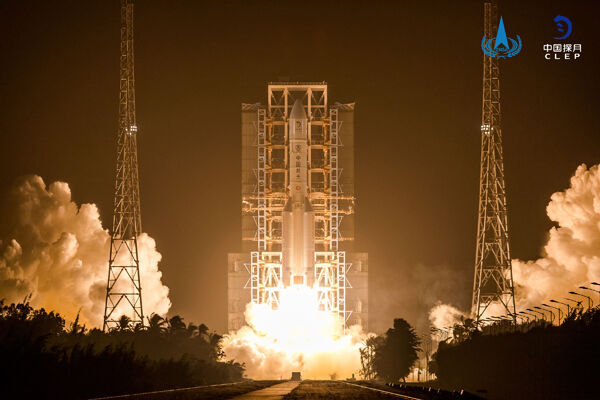
Chang'e 5 sets out to collect moon samples in landmark mission
"China launched a large robotic spacecraft early Tuesday morning at the Wenchang Space Launch Center in South China's Hainan province, tasking it with landing on the moon and bringing back lunar samples, 44 years after the last time such extraterrestrial substances were brought back to Earth. A Long March 5 heavy-lift carrier rocket, the biggest and mightiest launch vehicle in China, lifted its 20-story-tall body and soared skyward trailing a spectacular silver flame at 4:30 am from its launch pad, leaving many spectators inside and around the coastal Wenchang center in awe and excitement as the gigantic booster thundered skyward. The rocket was tasked with placing the 8.2-metric ton Chang'e 5, which has four components -- orbiter, lander, ascender and re-entry capsule -- in an Earth-moon transfer trajectory. China launches Long March 5 heavy-lift carrier rocket at the Wenchang Space Launch Center in South China's Hainan province on Nov 24 early morning. [XU JINGXING / CHINA DAILY] The heaviest and largest in the nation's lunar probe fleet, Chang'e 5 will fly in the trajectory within the next several days and make some correction operations before conducting a key braking maneuver to avoid accidentally flying past the moon. After its arrival in lunar orbit, the probe will fly around the celestial body for a certain period of time and will then separate into two parts, with the orbiter and re-entry capsule remaining in orbit while the lander-ascender combination descending to the lunar surface." [...]
Outras Notícias

PHP 8.0.0 Released!
"The PHP development team announces the immediate availability of PHP 8.0.0. This release marks the latest major release of the PHP language. PHP 8.0 comes with numerous improvements and new features such as: Union Types Named Arguments Match Expressions Attributes Constructor Property Promotion Nullsafe Operator Weak Maps Just In Time Compilation And much much more... Take a look at the PHP 8.0 Announcement Addendum for more information. " [...]

Mbed OS 6.5 released today
"The Mbed team are pleased to announce the release of Mbed OS 6.5 today. The main content is the introduction of our new command line tooling, Mbed CLI 2, which will co-exist alongside the existing Mbed CLI tools for now, but which we plan to replace entirely in the future. Back in August, my colleague Jaeden Amero introduced our plans for these tools in a blog As Jaeden explained then, because of the way the tools had evolved organically, the underlying architecture was such that developing new features was costly, difficult, and piled up technical debt. When we decided to develop the new command line tooling we wanted to ensure that the underlying architecture was extensible, to make it easy to add new functionality, more maintainable and gave Mbed developers a better experience than the existing tools. We also wanted to base the tools on existing open source solutions, and, after an evaluation, settled on CMake as best meeting our needs. As an aside, whilst we were busy developing the new tools, the superb team at the USC Rocket Propulsion Lab announced their CMake based alternative to Mbed CLI." [...]
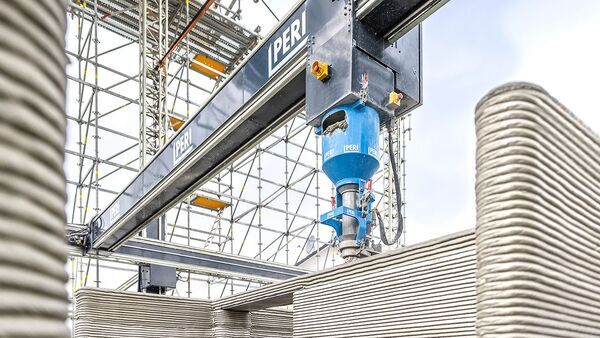
PERI builds the first 3D-printed apartment building in Germany
"Building consisting of 5 apartments across 3 floors with approx. 380 square metres of living space constructed using a 3D construction printer The largest printed apartment building in Europe is proof that 3D construction printing is also suitable for the construction of large dwelling units PERI GmbH has set about printing another residential building using a 3D construction printer, this time in Wallenhausen, Bavaria. At the end of September 2020, the family-owned company announced that work had begun on Germany’s first printed residential house in Beckum, North Rhine-Westphalia. Only two months later, work has begun on the next residential building to make use of 3D construction printing technology. Upon completion, the 5-in-a-block apartment building with around 380 square metres of living space will be the largest printed residential building in Europe. On this project, the printing process is expected to take six weeks." [...]

Introducing TSMC 3DFabric: TSMC’s Family of 3D Silicon Stacking, Advanced Packaging Technologies and Services
"Computing workloads have evolved more over the past decade than perhaps the previous four decades. Not too long ago, word processing, spreadsheets, presentation graphics and the occasional game of solitaire were the typical workload for even the most advanced processors in the world. Fast forward to 2020. The computing applications and workloads today are much more varied and demanding than those of previous decades. Cloud computing, big data analytics, artificial intelligence (AI) neural network training, AI inferencing, mobile computing on advanced smartphones and even self-driving cars are all pushing the computing envelope. With these new workloads, memory performance and power efficiency are also critical in product design." [...]
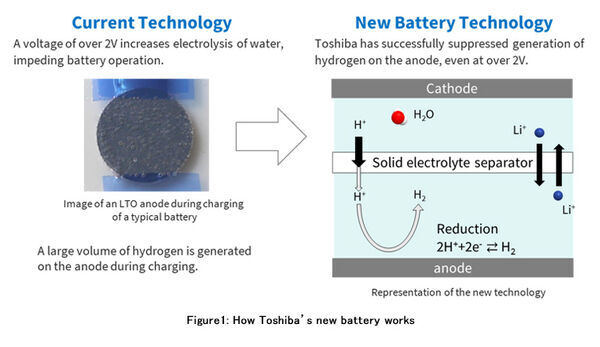
Toshiba Develops World’s First Aqueous Lithium-ion Battery with Nonflammable Electrolyte
"Toshiba Corporation has developed a prototype aqueous rechargeable lithium-ion battery that points the way to realization of the world's first aqueous large-capacity stationary storage battery that can operate at -30°C. Countering climate change and reducing greenhouse gas emissions will require greater reliance on renewable energy sources that are characterized by intermittent availability, and maximized utilization will only be possible with management systems integrating storage batteries that are safe and reliable over the long-term. Toshiba has addressed this concern by developing a battery cell that uses water as the aqueous electrolyte. The battery demonstrates low risk over the long term, even in the event of exposure to fire, which expands the range of locations where it can be installed. It also delivers the high durability of over 2,000 charge and discharge cycles, a performance that can contribute to expanded use of renewable energy. Details of the technology will be presented online at the 61st Battery Symposium in Japan on November 19, 2020." [...]
Ciência e Tecnologia
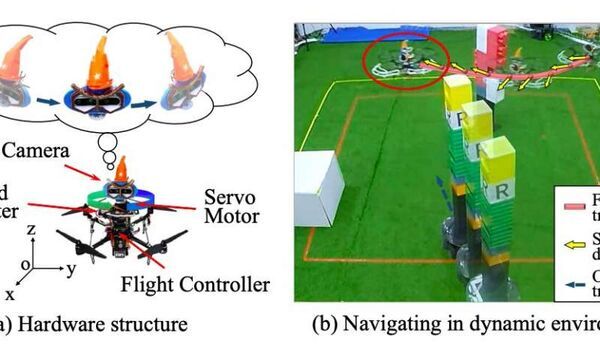
An obstacle avoidance system for flying robots inspired by owls
"When developing robotic systems and computational tools, computer scientists often draw inspiration from animals or other biological systems. Depending on a system's unique characteristics and purpose, in fact, nature typically offers specific examples of how it could achieve its goals rapidly and effectively. Researchers at Shanghai Jiaotong University have recently developed a new bio-inspired and computer vision-based obstacle avoidance system that could improve the navigation of flying robots operating in dynamic environments. This system, presented in a paper pre-published on arXiv, is inspired by how owls detect and avoid objects or other animals in their surroundings. "Although owls are unable to move their eyes in any direction (similarly to stereo cameras), they have a very flexible neck that can swivel up to 270 degrees, which enables them to rapidly observe even behind without relocating their torso," the researchers write in their paper. To replicate the way in which owls move their eyes in different directions and detect both static and moving objects around them, the researchers mounted a servo motor and a stereo camera on a quadrotor (i.e., an unmanned flying robot with four rotors)." [...]

Stretchable sensor gives robots and VR a human touch
"It’s not a stretch to say that stretchable sensors could change the way soft robots function and feel. In fact, they will be able to feel quite a lot. Cornell researchers have created a fiber-optic sensor that combines low-cost LEDs and dyes, resulting in a stretchable “skin” that detects deformations such as pressure, bending and strain. This sensor could give soft robotic systems – and anyone using augmented reality technology – the ability to feel the same rich, tactile sensations that mammals depend on to navigate the natural world. The researchers, led by Rob Shepherd, associate professor of mechanical and aerospace engineering in the College of Engineering, are working to commercialize the technology for physical therapy and sports medicine. Their paper, “Stretchable Distributed Fiber-Optic Sensors,” published Nov. 13 in Science." [...]
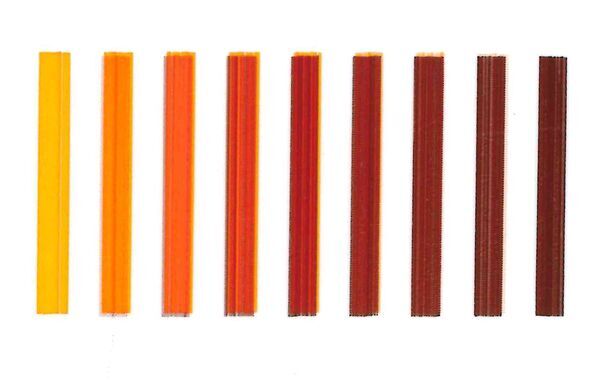
Solar cells: Mapping the landscape of Caesium based inorganic halide perovskites
"Scientists at HZB have printed and explored different compositions of caesium based halide perovskites (CsPb(BrxI1−x)3 (0 ≤ x ≤ 1)). In a temperature range between room temperature and 300 Celsius, they observe structural phase transitions influencing the electronic properties. The study provides a quick and easy method to assess new compositions of perovskite materials in order to identify candidates for applications in thin film solar cells and optoelectronic devices. Hybrid halide perovskites (ABX3) have risen up in only a few years as highly efficient new materials for thin film solar cells. The A stands for a cation, either an organic molecule or some alkali metal, the B is a metal, most often Lead (Pb) and the X is a halide element such as Bromide or Iodide. Currently some compositions achieve power conversion efficiencies above 25%." [...]
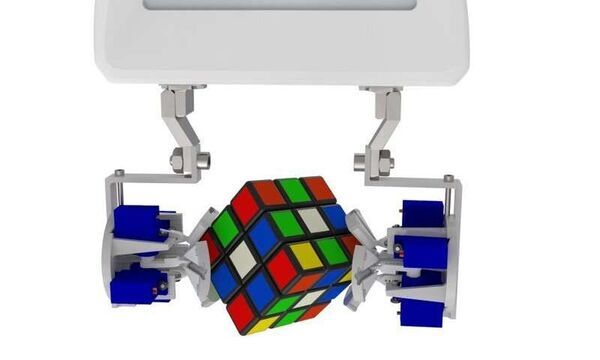
An origami-inspired robotic fingertip with shape-morphing capabilities
"To perform tasks that involve moving or handling objects, robots should swiftly adapt their grasp and manipulation strategies based on the properties of these objects and the environment surrounding them. Most robotic hands developed so far, however, have a fixed and limiting structure; thus, they can perform a limited number of movements and can only grasp specific types of objects. Researchers at Hong Kong University of Science and Technology have recently developed a robotic fingertip that can change its shape and switch across three different configurations, which could allow it to grasp a broader variety of objects. This fingertip's unique design, outlined in a paper presented at this year's IEEE International Conference on Automation Science and Engineering (CASE), is inspired by origami, the renowned Japanese art of paper folding. "Our study was inspired by two common observations in current research and industrial applications," Zicheng Kan and Yazhan Zhang, two of the researchers who carried out the study, told TechXplore via email. "The first relates to parallel grippers developed in past research studies, which could help to achieve industrial automation." [...]

Researcher sets record for quantum chemistry calculation
"A researcher from The Australian National University (ANU) has used one of the most powerful supercomputers in the world to predict the quantum mechanical properties of large molecular systems with an accuracy that surpasses all previous experiments. Calculations of this type have the potential to solve important problems in energy generation, fuel production, water purification, and the manufacturing of medicines, foods, textiles, and consumer goods. By running his new algorithms on the Summit supercomputer at the Oak Ridge National Lab in the USA, Dr Giuseppe Barca has broken the world record for the largest Hartree-Fock calculation ever performed, setting new standards in High-Performance Computing. The Hartree-Fock method helps determine the electronic structure and the energy of a quantum mechanical molecular system. The calculation ran for just over half an hour using 26,268 NVIDIA V100 Graphics Processing Units (GPUs) and simulated 20,063 water molecules at a resolution never before possible. "The new algorithm brings quantum mechanical calculations to the next level in terms of molecular sizes, enabling us to reach scales so large they belong to the domains of biology," Dr Barca said." [...]

Improving quantum dot interactions, one layer at a time
"Osaka City University scientists and colleagues in Japan have found a way to control an interaction between quantum dots that could greatly improve charge transport, leading to more efficient solar cells. Their findings were published in the journal Nature Communications. Nanomaterials engineer DaeGwi Kim led a team of scientists at Osaka City University, RIKEN Center for Emergent Matter Science and Kyoto University to investigate ways to control a property called quantum resonance in layered structures of quantum dots called superlattices. “Our simple method for fine-tuning quantum resonance is an important contribution to both optical materials and nanoscale material processing,” says Kim. Quantum dots are nanometer-sized semiconductor particles with interesting optical and electronic properties. When light is shone on them, for example, they emit strong light at room temperature, a property called photoluminescence." [...]
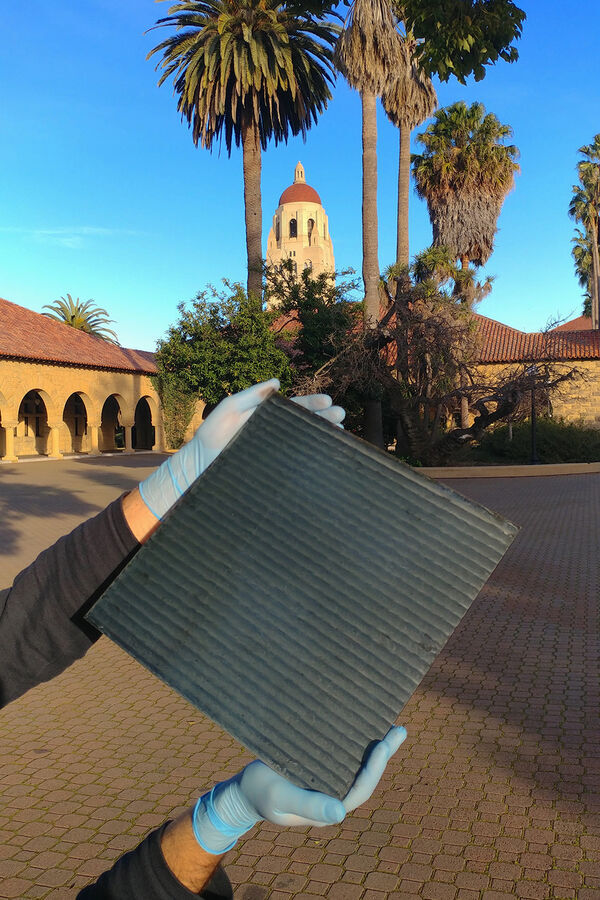
Stanford scientists invent ultrafast way to manufacture perovskite solar modules
"High-speed manufacturing could advance the commercialization of perovskite modules, a green alternative to conventional solar panels made of silicon. Most solar cells today are made with refined silicon that turns sunlight into clean electricity. Unfortunately, the process of refining silicon is far from clean, requiring vast amounts of energy from carbon-emitting power plants. For a greener alternative to silicon, researchers have focused on thin-film perovskites – low-cost, flexible solar cells that can be produced with minimal energy and virtually no CO2 emissions. While perovskite solar cells are promising, significant challenges need to be addressed before they can become commonplace, not least of which is their inherent instability, which makes manufacturing them at scale difficult. “Perovskite solar technology is at a crossroads between commercialization and flimflammery,” said Stanford University postdoctoral scholar Nick Rolston." [...]

Quantum nanodiamonds may help detect disease earlier
"The quantum sensing abilities of nanodiamonds can be used to improve the sensitivity of paper-based diagnostic tests, potentially allowing for earlier detection of diseases such as HIV, according to a study led by UCL researchers in the i-sense McKendry group. Paper-based lateral flow tests work the same way as a pregnancy test in that a strip of paper is soaked in a fluid sample and a change in colour – or fluorescent signal – indicates a positive result and the detection of virus proteins or DNA. They are widely used to detect viruses ranging from HIV to SARS-CoV-2 (lateral flow tests for Covid-19 are currently being piloted across England) and can provide a rapid diagnosis, as the results do not have to be processed in a lab. The new research, published in Nature, found that low-cost nanodiamonds could be used to signal the presence of an HIV disease marker with a sensitivity many thousands of times greater than the gold nanoparticles widely used in these tests. This greater sensitivity allows lower viral loads to be detected, meaning the test could pick up lower levels of disease or detect the disease at an earlier stage, which is crucial for reducing transmission risk of infected individuals and for effective treatment of diseases such as HIV. The research team are working on adapting the new technology to test for COVID-19 and other diseases over the coming months." [...]
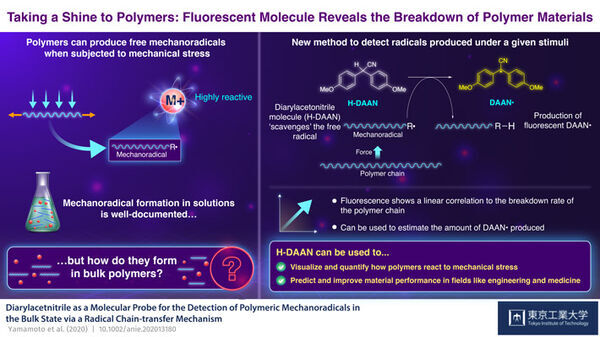
Taking a Shine to Polymers: Fluorescent Molecule Betrays the Breakdown of Polymer Materials
"Scientists at the Tokyo Institute of Technology (Tokyo Tech) have come up with a simple method to evaluate the strength and performance of polymer materials. They present their innovation in the latest issue of Angewandte Chemie International Edition, and hope that their work will enable scientists and engineers to better evaluate the polymers they work with, and eventually synthesize better ones. Nylon, rubber, silicone, Teflon, PVC – these are all examples of man-made polymers – long chains of repeated molecular units that we call monomers. While polymers also exist in nature (think wool, silk, or even hair), the invention of synthetic polymers, the most famous of which is plastic, revolutionized the industry. Light, stretchy, flexible, yet strong and resistant, synthetic polymers are one of the most versatile materials on the planet, used in everything from clothing to building, packaging and energy production. Since the very beginning of this new era in material engineering, understanding the influence of external forces on polymers' strength and stability has been crucial to evaluate their performance." [...]
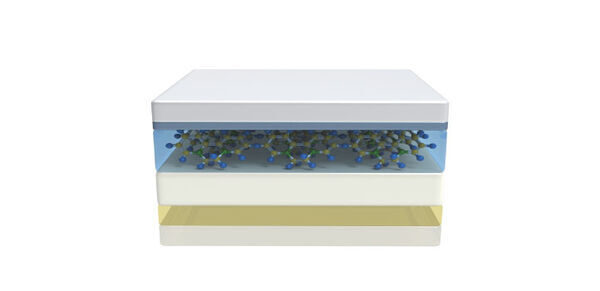
Guiding the way to improved solar cell performance
"Small molecules could hold the key to enhancing the efficiency of organic solar cells. Understanding how particles travel through a device is vital for improving the efficiency of solar cells. Researchers from KAUST, working with an international team of scientists, have now developed a set of design guidelines for enhancing the performance of molecular materials. When a packet of light, or photon, is absorbed by a semiconductor, it generates a pair of particles known as an exciton. An electron is one part of this pair; the other is its positively charged equivalent, called a hole. Excitons are electrically neutral, so it is impossible to set them in motion by applying an electric field." [...]

Quantum magic squares
"The magic of mathematics is particularly reflected in magic squares. Recently, quantum physicist Gemma De las Cuevas and mathematicians Tim Netzer and Tom Drescher introduced the notion of the quantum magic square, and for the first time studied in detail the properties of this quantum version of magic squares. Magic squares belong to the imagination of humanity for a long time. The oldest known magic square comes from China and is over 2000 years old. One of the most famous magic squares can be found in Albrecht Dürer's copper engraving Melencolia I. Another one is on the facade of the Sagrada Família in Barcelona." [...]

3D printed electrodes free the gas
"Alkaline water electrolysis has been touted as a path to establish a hydrogen economy by converting intermittent renewable energies into clean hydrogen-based chemical energy. However, current technology has achieved only low current densities and voltage efficiencies. To make electrolysis more resourceful, a Lawrence Livermore National Laboratory (LLNL) team partnered with the University of California, Santa Cruz and two other institutions to develop a 3D-printed electrode that lessens the problems that occur with gas bubbles that are generated in the process. One key to making electrolysis achieve higher current density comes down to the gas bubbles created in the process. The bubbles often mingle together, jam and get trapped, making it difficult for them to escape. “This new electrode gets rid of the gas bubbles faster." [...]

Supersized Wind Turbines Generate Clean Energy—and Surprising Physics
"Twenty years ago, wind energy was mostly a niche industry that contributed less than 1% to the total electricity demand in the United States. Wind has since emerged as a serious contender in the race to develop clean, renewable energy sources that can sustain the grid and meet the ever-rising global energy demand. Last year, wind energy supplied 7% of domestic energy demand, and across the country—both on and offshore—energy companies have been installing giant turbines that reach higher and wider than ever before. "Wind energy is going to be a really important component of power production," said engineer Jonathan Naughton at the University of Wyoming, in Laramie. He acknowledged that skeptics doubt the viability of renewable energy sources like wind and solar because they’re weather dependent and variable in nature, and therefore hard to control and predict. "That's true,” he said, "but there are ways to overcome that."" [...]

Direct visualization of quantum dots reveals shape of quantum wave function
"Researchers used a scanning tunneling microscope to visualize quantum dots in bilayer graphene, an important step toward quantum information technologies Trapping and controlling electrons in bilayer graphene quantum dots yields a promising platform for quantum information technologies. Researchers at UC Santa Cruz have now achieved the first direct visualization of quantum dots in bilayer graphene, revealing the shape of the quantum wave function of the trapped electrons. The results, published November 23 in Nano Letters, provide important fundamental knowledge needed to develop quantum information technologies based on bilayer graphene quantum dots. “There has been a lot of work to develop this system for quantum information science, but we’ve been missing an understanding of what the electrons look like in these quantum dots,” said corresponding author Jairo Velasco Jr., assistant professor of physics at UC Santa Cruz. While conventional digital technologies encode information in bits represented as either 0 or 1, a quantum bit, or qubit, can represent both states at the same time due to quantum superposition. In theory, technologies based on qubits will enable a massive increase in computing speed and capacity for certain types of calculations." [...]
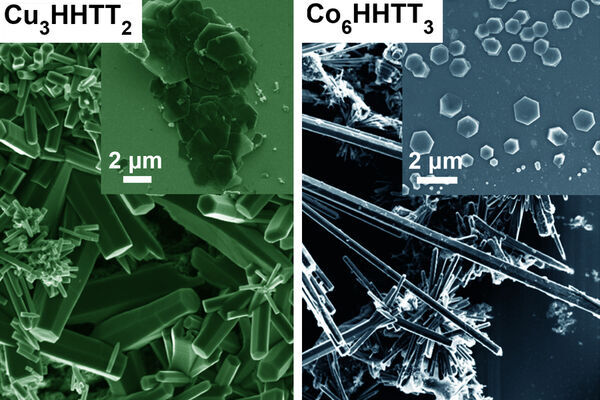
Researchers decipher structure of promising battery materials
"Family of compounds could someday be useful for fuel cells, supercapacitors, catalysts, and sensors. A class of materials called metal organic frameworks, or MOFs, has attracted considerable interest over the last several years for a variety of potential energy-related applications — especially since researchers discovered that these typically insulating materials could also be made electrically conductive. Thanks to MOFs’ extraordinary combination of porosity and conductivity, this finding opened the possibility of new applications in batteries, fuel cells, supercapacitors, electrocatalysts, and specialized chemical sensors. But the process of developing specific MOF materials that possess the desired characteristics has been slow. That’s largely because it’s been hard to figure out their exact molecular structure and how it influences the material’s properties. Now, researchers at MIT and other institutions have found a way to control the growth of crystals of several kinds of MOFs." [...]

A new graphene-based nanoscale sensor enables detection of a single carbon dioxide molecule - Breakthrough for future environmental sensing technology
"A research group at School of Materials Science / Energy and Environment division at Japan Advanced Institute of Science and Technology (JAIST, President Testuo Asano), succeeded to detect a single CO2 molecule electronically by using a newly developed nano-scale sensor device with a suspended graphene, which will have major implications for future environmental sensing and monitoring technologies. In recent years, health problems due to air pollution in the personal living space are getting serious as represented by sick building syndrome (SBS). Very dilute chemical gas molecules such as volatile organic compounds (VOC) originated from building and interior materials, furniture and even from daily commodities adversely affect us living in modern houses with good insulation. Sick car and sick school syndromes have also become issues recently. Over one million patients presumably suffer from those syndromes in Japan. However, those harmful chemical gases are very dilute with concentration of low ppb (parts per billion) level and it is extremely difficult to detect with the current gas sensor technology." [...]
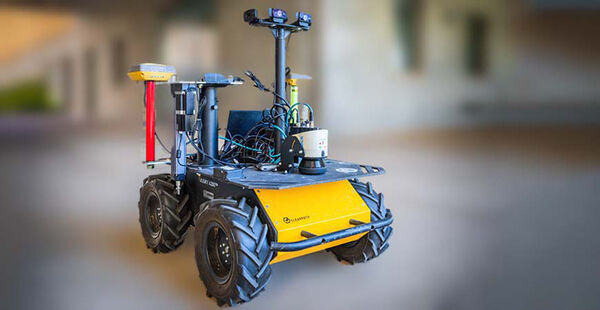
A robot that tells growers when to water crops is on the way
"Every backyard gardener knows how hard it can be to tell when to water the plants. Multiply that by tens or hundreds of acres and it’s easy to see the challenges growers face keeping their crops healthy while managing water resources wisely. To determine water needs accurately, growers hand-pluck individual leaves from plants, put them in pressure chambers, and apply air pressure to see when water begins to leak from the leaf stems. That kind of testing is time consuming and means growers can only reach so many areas of a field each day and cannot test as frequently as needed to accurately determine optimal irrigation scheduling patterns. A group of researchers from UC Riverside and UC Merced have received a grant for more than $1 million from the U.S. Department of Agriculture through the National Science Foundation’s National Robotics Initiative to address these challenges. From UC Riverside are Assistant Professor Konstantinos Karydis and Professor Amit K. Roy-Chowdhury, both from the Department of Electrical and Computer Engineering." [...]

Replicating Surfaces, Right Down to a Fraction of an Atom
"The ability to replicate materials at the atomic level has attracted significant attention from materials scientists. However, the current technology is limited by a number of factors. Udo Schwarz, professor of mechanical engineering & materials science and department chair, has recently published two papers on research that could significantly open up what’s possible within this emerging field. His methods include a process that can replicate a surface’s features to details of less than one 10 billionth of a meter, or less 1/20th the diameter of an atom. Nanostructured and nanopatterned surfaces are an integral component in many nanotechnological applications. Easy to use and economical, the method of nanoimprinting has great potential for applications such as high-density data storage, photonic devices, holograms, bio-nanofluidic chips, water filtration, and electrodes in fuel cells." [...]
Documentação
A documentação é parte essencial do processo de aprendizagem e a Internet além de artigos interessantes de explorar também tem alguma documentação em formato PDF interessante de ler. Todos os links aqui apresentados são para conteúdo disponibilizado livremente pelo editor do livro.
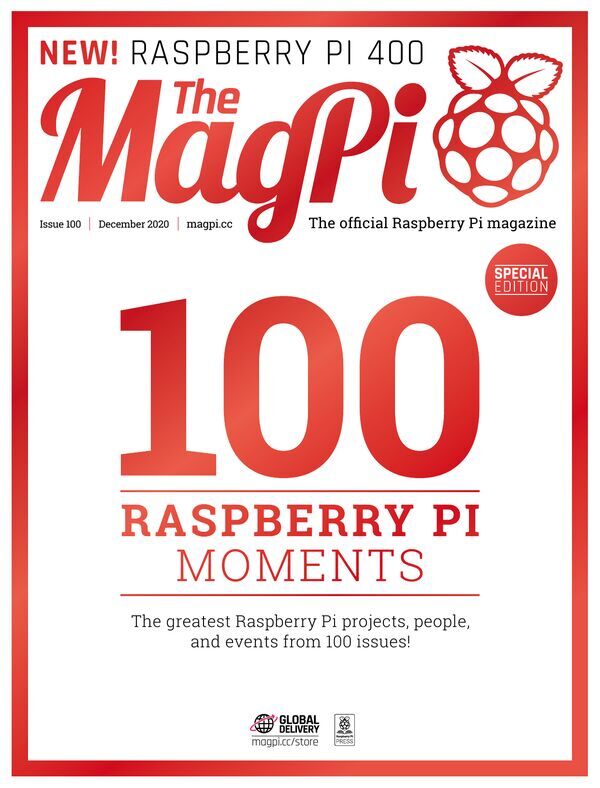
The MagPI 100
"The MagPi magazine is 100 issues young. Come with us and celebrate with this special edition of The MagPi magazine. Inside you’ll discover a 20-page feature celebrating 100 moments from Raspberry Pi history. Inside The MagPi magazine #100 Special red-foil cover. Buy The MagPi magazine #100 in print to discover a unique cover that unfolds to reveal all 100 previous editions. 100 Raspberry Pi moments." [...]

newelectronics 24 Novembro 2020
"New Electronics is a fortnightly magazine focusing on technological innovation, news and the latest developments in the electronics sector. Downloadable as a digital page turner or pdf file, or offered as a hard copy, the New Electronics magazine is available in a format to suit you. " [...]
Projetos Maker
Diversos Projetos interessantes.

RGB Large Digital Clock
"Not your typical wall clock that tells time, it also becomes your wall light panels that lit up your scifi-like bedroom. I wanted to customize how to my room apartment looks like. I love RGB LED strips and how much you can do to it. So, I decided to build my own digital clock that is large enough to make some mood while working or gaming. Let's jump right to the 3d printing. Unfortunately, I was not able to logged the 3d design process." [...]
World's Slimmest NeoPixel LED Matrix
"This is a 8x8 WS2812b NeoPixel LED matrix that is completely flat surface and has the same 1.6mm height as a normal PCB. I always had this idea of what would have happened if we can put the components inside the PCB? Let's find out! This is the world's slimmest addressable RGB LED matrix that can be made with 5050 WS2812b NeoPixel LEDs. Why? Because on this PCB the LEDs are not actually on top of the PCB, rather it's inside the PCB." [...]
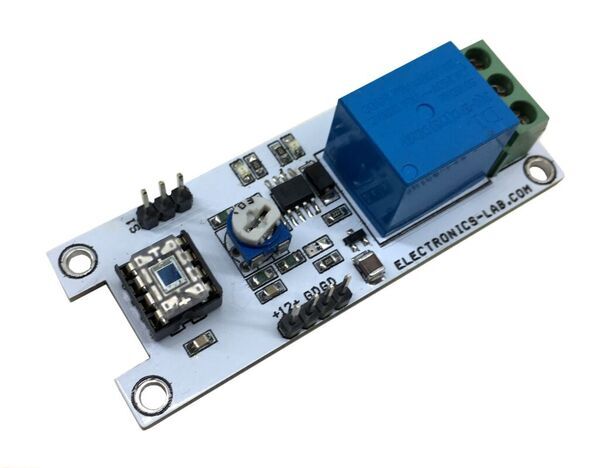
Analog Light Sensor + Light Sensitive Switch using OPT101
"You may have seen many light-sensitive switch circuits based on an LDR sensor. Usually, the sensitivity of the LDR based light sensor is poor. We wanted a very sensitive light switch hence we decided to make a circuit based on a light sensor rather than LDR. After a little research on the internet, we found the OPT101 light sensor chip which includes a photodiode and a transimpedance amplifier in one package. The OPT101 light sensor provides an analog voltage output linearly proportional to light intensity. This board has a dual function, it can act as a Light Sensor and a Light Sensitive switch." [...]
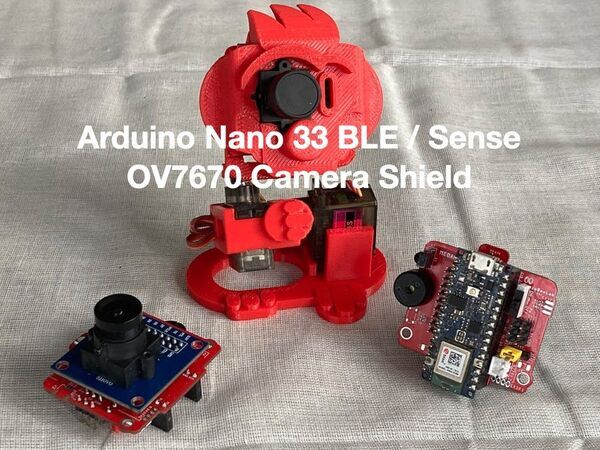
Arduino Nano 33 BLE OV7670 Camera Shield
"Embedded machine vision board, make your robotics ML enable. Arduino Nano 33 BLE processing capacity is moderately high for the low power consumption embedded system. Since it has many sensors on board, it seems to be very fun to run TinyML like software. I thought it would be even more fun to connect vision, so I created a board with a low-cost camera OV7670 (around $3) connected. In addition, the necessary power supply control, PWM controller IC for offloading servo processing, speakers, IR receiver, etc. were mounted." [...]

Otto Biped with Arduino MKR1010 and MKR RGB Shield
"We will use the Arduino MKR1010 together with MKR RGB Shield with Otto showing his expression with his eyes. Biped Otto with Arduino We set up a biped using the open source file Otto DIY programmed on the MKR1010 WiFi card with the MRK RGB Shield to make the eyes blink and angry. The goal of using the MKR WiFi card is to connect Otto to the Arduino Cloud to send commands remotely over the internet. I used 6 servo motors and in the programming we created a left step and right step function, the parameters that you will pass in the function must be adjusted according to your assembly, because the weight of the biped and the position of the servo motor are influencing factors in the step. " [...]
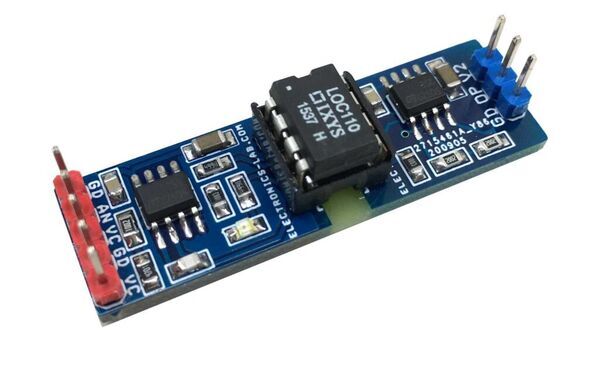
Optically Isolated Analog Input Module for Arduino
"This is an isolated analog input module that is useful for interfacing Analog signals of various types originated from analog sensors and field devices. The module is very useful for in-process controls, factory automation, industrial applications, etc. Interfacing an analog voltage, an analog sensor to Arduino or other various microcontrollers with optical isolation is very easy with this module. The circuit requires two power supplies for the input and output sides. The module takes 0 to 5V analog input and provides optically isolated 0-3.3V as output. The circuit can also be interfaced with a 10V sensor, for 0 to 10V input, change the resistor R3 to 1.8K and the output will be the same 0 to 3.3V." [...]
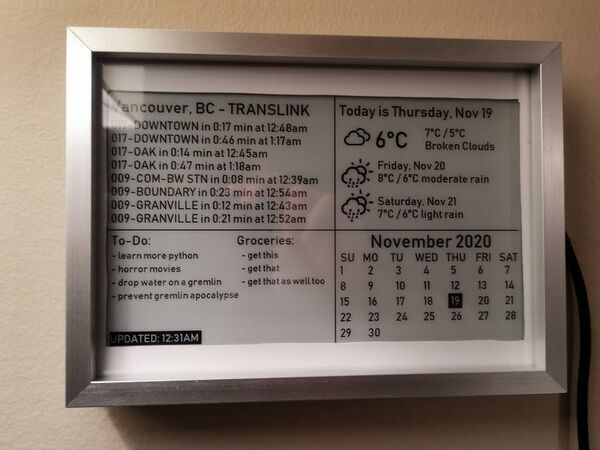
E-ink Dashboard
"This is a E-ink dashboard that provides real-time information pulled from API using a Raspberry Pi Zero. I've always been interested in projects that provide you real-time information from selected sources, seeing people doing smart mirror projects made me want to do one for myself, one of the biggest reasons that I ended up doing this project was to help my partner in life in her mornings, she uses transit to go to work and this dashboard would provide her information of coming buses to our closest stops and what the current weather would be at the moment. I opted to use an e-paper display instead of an LCD due low power consumption, I've seen a lot of projects that provide you things like the weather, calendars or a task list that use a normal raspberry pi, I wanted something that could be hanged in the wall and possibly hidden within the frame, the raspberry pi zero w was a pretty good option. I had some knowledge of python from my work but still wanted to improve and learn more, this project helped me improve greatly on it, reading the instructions from the e-paper hat and seeing how other projects worked they provided me a great example. The way it works its pretty simple, you register on the site where you want to pull the information for an API key, then using the requests library to provide you a JSON list, once you have the information you are looking for you only need to format it to your liking, render it into a PNG with the PIL library and send it to the e-paper display. The first version I created, got the modules for transit (4 stops with 2 times each), the weather (current and 2 days forecast) and regular monthly calendar." [...]
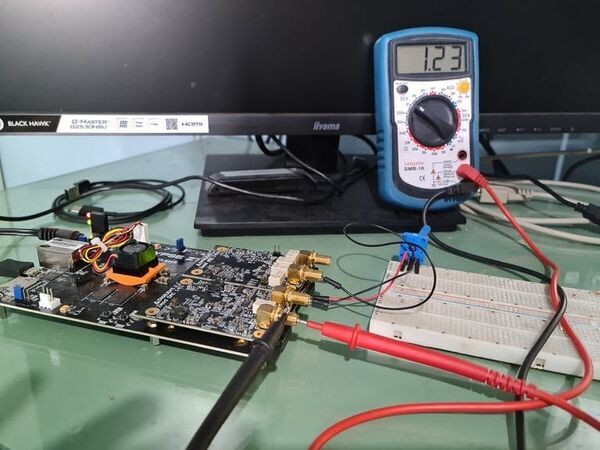
Eclypse-Z7: Zmod ADC to Zmod DAC Loop
"This project will go trough the process of acquiring an input signal through the Zmod ADC and re-creating the signal through the Zmod DAC. Introduction Oh, the world of digital processing has moved fast this decade! when it comes to high speed digital signal processing, engineers no longer have the simple choice of a digital signal processor. Engineers and hobbyists alike must consider the relatively young and modern SoC (System on Chip). Especially when it comes to very high speed signal processing applications such as RF, the SoC must have an edge over a classical signal processor. Especially the case for the Zynq-7000 SoC which contains a relatively large FPGA (Programmable Logic) and dual (or single according to the chip) core A9 ARM processors (Processing System)." [...]
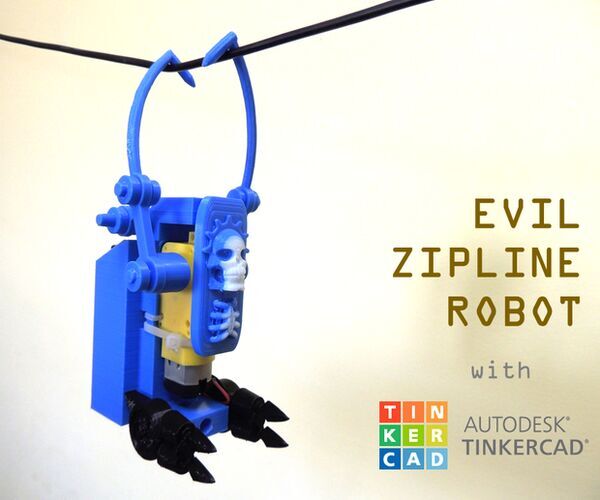
Tinkercad Robotics for School: Evil Zipline Robot!
"Hello! My name is Mario. Welcome you to a new lesson of "Tinkercad Robotics for School", where you can learn how to use Tinkercad to create simple and easy fun machines! Today's challenge: we will create an Evil Zipline Robot! This little plastic machine can walk along a string or cable, sloth-style. I'm in love with this kind of machines since I was a kid and I saw this little bot in an episode of "The Wizard", an 80's TV series about a toys inventor." [...]
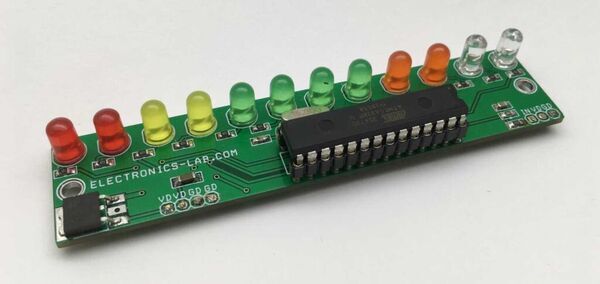
Lead Acid Battery Voltage Monitor using ATMEGA328
"Monitoring the voltage level of a 12V Lead Acid Battery (SLA) is easy and simple with this project. The board is made using an ATMEGA328 micro-controller and 12 x 5mm LEDs. The ATMEGA328 microcontroller senses the analog voltage on A3 Analog pin and drives 12 LEDs connected to digital I/O pins of the chip. Input voltage from the battery is dropped using divider resistors. Different colors of LEDs used for easy visualization of battery voltage level. The operating supply of the circuit is 7-15V DC." [...]
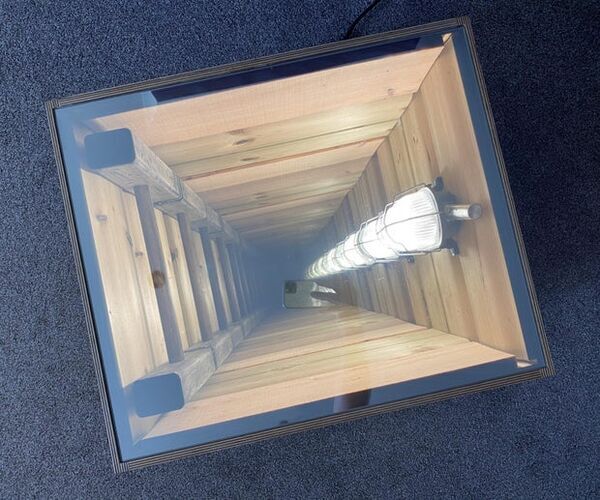
Deep Hole in a Small Box, a Different Take on the Infinity Mirror.
"First off I must give credit for the inspiration to these two Reddit posts, this is the first one I saw and this is the one that inspired that first one. Having seen these I knew it was something I wanted to make. I hope this Instructable inspires you to pick up the tools and give it a go. I completely messed up my first attempt by trying to use some beach and ash offcuts that I unsuccessfully jointed, this is version 2 and so much better. The final product is impressive, even if I do say so myself. Supplies: Most of the supplies will depend on the size of the box you're planning to make." [...]
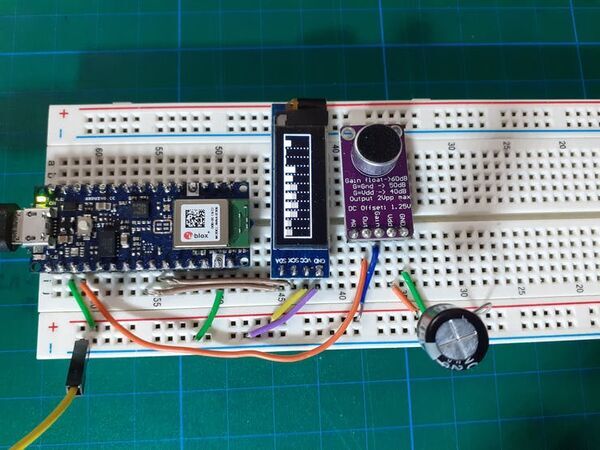
Sound Spectrum Visualizer with Arduino Nano 33 BLE
"Visualize sound frequencies spectrum with an OLED 128x32 display, Arduino Nano 33 BLE and an electret microphone amplifier (MAX9814). See how a bar graph respond to music and sound in a little OLED display. Lowest frequencies toward the left end of the graph, highest frequencies toward the right. Connections Connect Mic GAIN depending the sensibility that better suits your system: VCC to mic GAIN for 40dB, low sensitivity, GND to mic GAIN for 50dB, medium sensitivity or let floating the mic GAIN for 60dB, high sensitivity. Connect Analog pin 0 A0 to mic amp OUT Connect 3.3V, GND, SDA (or analog 4 A4) and SCL (analog 5 A5) to I2C SSD1306 connect a 470 uF capacitor between VCC and GND in power bus Getting low frequency noise? The noise comes from any electric devices near your measuring system that are working." [...]

Ruler to Caliper (0.1mm Resolution!) - 3D Printed (Left Handed Version Included!)
"I recently ordered a digital caliper from China. Spent 20$ on it, and it's completely worthless - totally unreliable. After I was done mourning over my 20$, I decided to make my own. For those of you who are unfamiliar with what a caliper is, it's a tool that is most often used to measure out/inner diameters of objects, and there are more than a few instructables on how to use them. I figured that if I base my caliper on a ruler, which is super cheap and 100% reliable, I could end up with a very reliable caliper. Also, by using adding a Vernier scale I could reach a resolution of 0.1mm." [...]
Neopixel Led Ring Ornament
"Hi and happy holidays to you all! If you take look at my profile, it's clear that I'm somewhat of an LED addict. This addiction more or less began a few years ago when tinkering with commonly available WS2812B (aka Neopixel) rings. My mom suggested putting the rings on our Christmas tree, and so, after some soldering (and some crafting help from mom!) my LED ornament was born. I have since updated the ornament, which I'll present to you today." [...]

Full Digital FM Receiver With Arduino and TEA5767
"FM transmitters/receivers are among the top favorite circuits of any electronic enthusiast. In this article/video, I have introduced a complete digital FM receiver design that has equipped with an LCD screen and three push-buttons. It can search for the FM signals from 76MHz to 108MHz manually and automatically (Scan mode). The signal strength is also displayed as a bar graph on the LCD screen. The output sound is amplified by a 3W+3W Class-D stereo amplifier that handles high-quality and strong enough audio power. As a controller, I have used the cheap and popular Arduino-Nano board." [...]
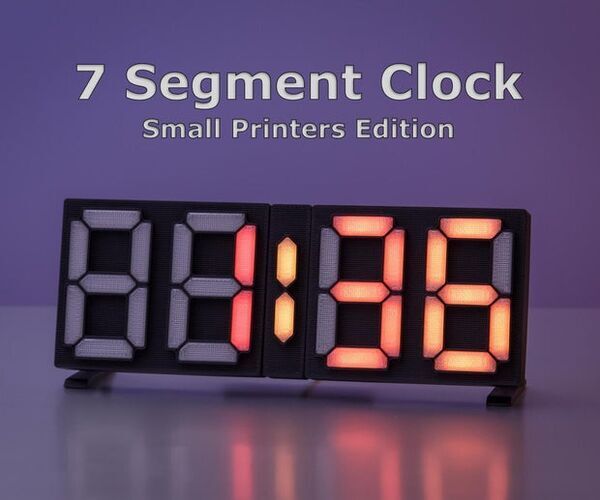
7 Segment Clock - Small Printers Edition
"Yet another 7 Segment Clock. xD Although I have to say it doesn't look that crazy when watching my Instructables profile. It probably get's more irritating the moment you have a look at my thingiverse profile. So why did I even bother to do another one? Actually the answer is pretty simple... While playing around with another project I came up with another way to route the led strip inside the modules." [...]

A Simple Raspberry Pi Electronic Organ Based on MPR121
"I am a big fan of TwoSetViolin, they bring me a lot of fun and I start to appreciate the joy of music since I followed their channel last year. They have a program called LINGLING40HOURS, in which there are many linglings (talented fans) showing their music memes. Well, I know nothing about instruments, so it’s hard for me to come up with any good music memes. Okay, at last, I decided to utilize my expertise to DIY an electronic organ to join them. Supplies: Hardware Raspberry Pi 4B X1 Raspberry Pi IO Expansion Board X1 Capacitive Touch Kit For Arduino X1 Gravity: Digital Speaker Module X1 Ice Cream Sticks (3*7) Double Side Adhesive Copper Foil Tape with Double-Sided Conductive Conductor Wire Cardboard Type-C power cable Ethernet Cable X1 (Can be replaced by WiFi)" [...]
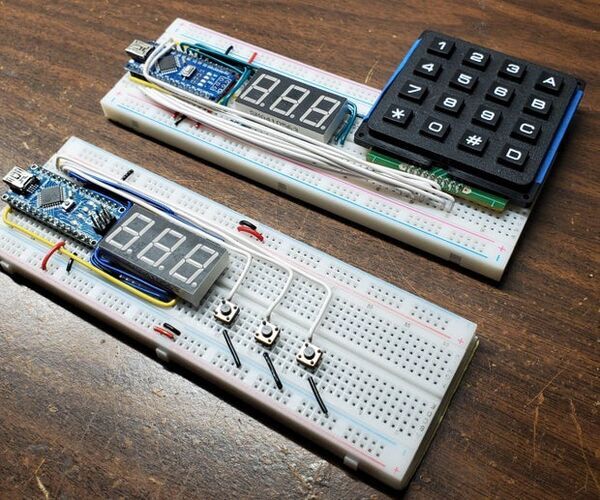
Arduino Psychic
"This is a magic trick done using two Arduinos. One Arduino is a random# generator, the other Arduino will identify a random # chosen by the audience. Please watch the video. It's easier shown than explained. :-( Supplies: Any two Arduinos (I used two Arduino Nanos) Any two or more digit 7-segment display. Sketch is coded for common anode, but it would be simple to modify the sketch for common cathode." [...]

Alexa IoT TV-Controller ESP8266
"Recently I bought an Amazon Echo Dot during the Amazon Prime day for ~20€. These small voice assistants are cheap and great for DIY Home Automation if you know what is possible and how to build smart devices. I have an Samsung Smart TV but I wanted to make it even smarter. In this Instructable I will show you how to build a Controller for your TV to control it wirelessly using your voice. Some possible and useful commands could be: Turn On/Off the TV Volume Settings (Up/Down/Mute) Switch to another source (HDMI Port, TV, etc...) Turn on Netflix/Amazon Prime/YouTube... In case your TV has an USB-Port that is always-on you have the jackpot!" [...]
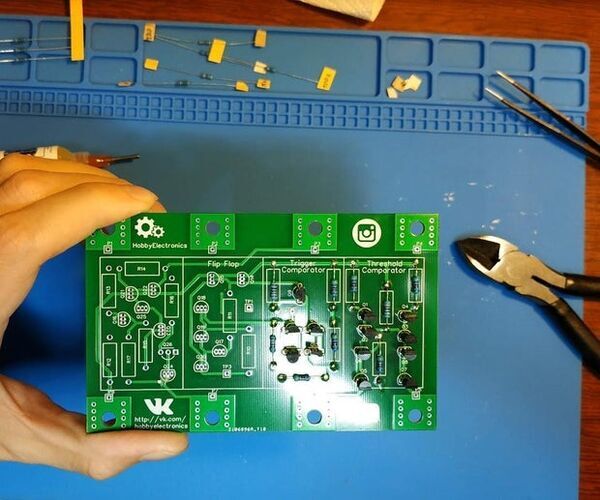
Designing a 555 Timer on Discrete Elements
"I designed the circuit board for the NE555 timer and it works! Try it too! Hello! My name is Vladimir, I am a programmer and electronics developer. Analog circuitry has always been my weak point, and therefore the idea came to me to develop a tutorial on the internals of the NE555 timer. You may have seen similar boards from Mad Evil Scientist, and others on this site." [...]

TinyML Keyword Detection for Controlling RGB Lights
"Train a TensorFlow model to recognize certain keywords and control an RGB light strip using an Arduino Nano 33 BLE Sense. The Premise Machine learning at the edge is extremely useful for creating devices that can accomplish "intelligent" tasks with far less programming and logical flow charts compared to traditional code. That's why I wanted to incorporate at-the-edge keyword detection that can recognize certain words and then perform a task based on what was said. Hardware This project just has one component: an Arduino Nano 33 BLE Sense. The actual magic happens in the machine learning model. The Arduino Nano 33 BLE Sense is full of sensors, including a microphone, 9-axis IMU, environmental sensor, and a gesture/proximity/color/ambient light sensor (APDS-9960)." [...]
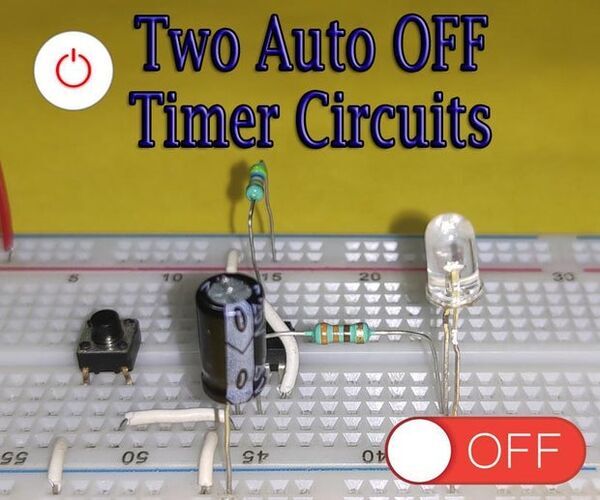
Two Auto-OFF Timer Circuits || 555 IC or Transistor
"The Timer circuit turns ON when connection is given and turns OFF automatically after few seconds, depending on the value of Capacitor used in the circuit. Here, I will show you two different ways to make this circuit using : 1. 555 Timer IC 2. Transistor Pushing the push button switch turns ON the output (LED), which then turns OFF automatically after few seconds, influenced by the capacitance used. " [...]

Mindwave Wheelchair
"This project attempts to implement a device to control a wheelchair for paralyzed patients with an improved controlling method. The device should be able to move the wheelchair freely in anywhere under the control of the user and it is not required to predefine any map or path. An accurate and natural controlling method is provided, and the user can stop the wheelchair any time immediately to avoid risks or danger. This project is using a brainwave-reading cap to collect the EEG/EMG signal and send it to the Arduino UNO to control the movement of the wheelchair. Supplies: Computer Ultracortex "Mark IV" EEG Headset Cyton Biosensing Board (8-channels) Arduino UNO Motor shield DC Motors Wires" [...]
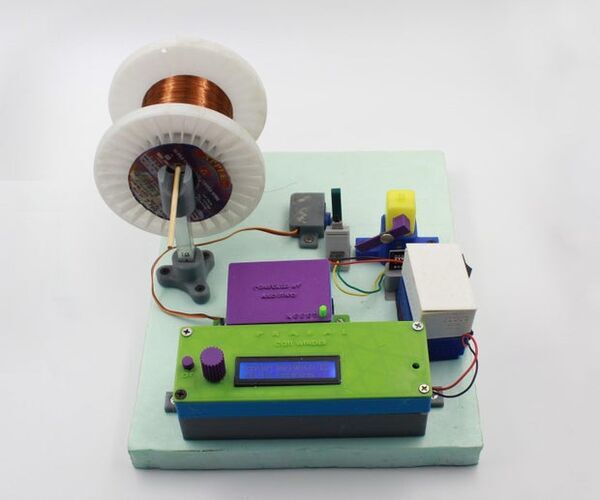
Coil Winder Using Arduino
"Why this project was built? I work at Prabal Learning Innovations, an educational startup. One of our educational kits contains a 3D printed part that is wound with a copper coil to demonstrate electromagnetic induction. Winding the 3d printed part usually requires two people, one to hold the motor and the other to hold the 3D printed part. So, I built this machine, to do the job. P.S." [...]
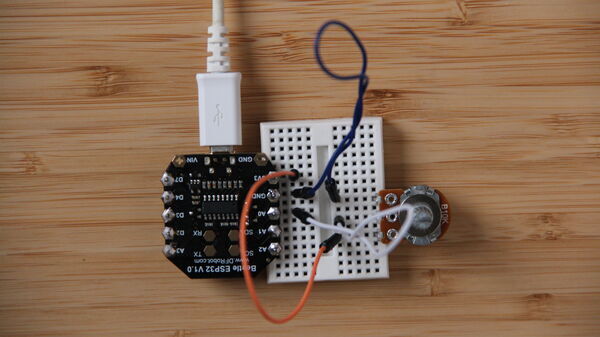
Create Apps for the ESP32 Using BLE Through P5
"The ESP32 is cool, but it is cooler when you can make your own apps for it. In this tutorial, we will guide you to use BLE-UART to do so. Story It is quite tricky to get Arduino (and its hardware connected to it) talking to a screen; like a phone, iPad or laptop. This code helps you to connect an ESP32 to software you develop yourself. This will help you to prototyping hardware connected apps, make interactive games and interactive installations for exhibitors. I've made some tutorials, one to use the ESP32 as a bluetooth keyboard, to connect any serial device to P5 using webSerial, to connect a micro:bit to P5 using BLE so the only thing still needed is to communicate with an ESP32 using Bluetooth Serial." [...]
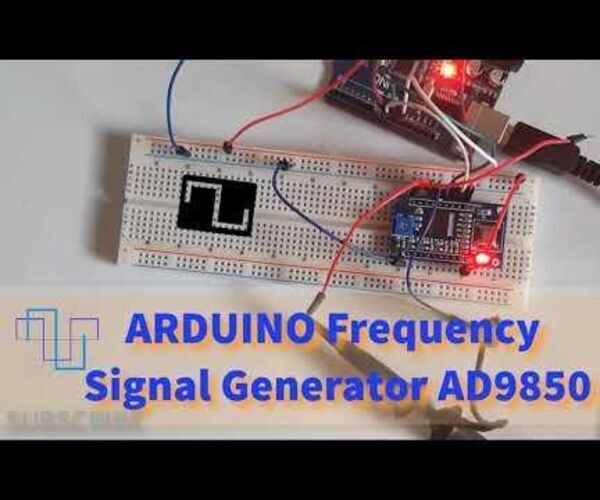
How to Use Arduino DDS Frequency Signal Generator AD9850
"In this Tutorial we will learn how to make a Frequency Signal Generator using a AD9850 module and Arduino. Watch the Video! Note: I managed to get frequency up to +50MHz but the signal quality gets worse with the higher frequencies. " [...]
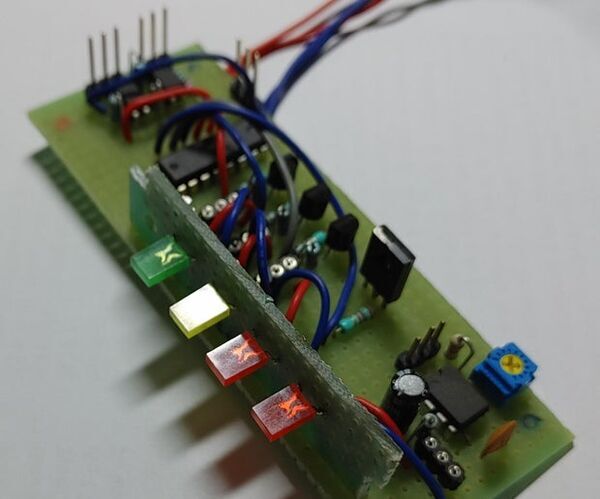
Raspberry Pi CPU Temperature Indicator
"Previously I had introduced simple raspberry pi (Hereinafter as RPI) operational status indicator circuit. This time, Ill explain some more useful indicator circuit for RPI running as headless (without monitor) manner. The circuit above shows CPU temperature into 4 different levels such as: - Green LED turned on when CPU temperature is within 30~39 degree - Yellow LED indicates temperature is increased in range of 40 to 45 degree - 3rd Red LED shows CPU become a little bit hot by reaching 46 ~ 49 degree - Another Red LED will blink when temperature is exceeding more than 50 degree The above CPU temperature ranges are my personal design concept (Other temperature ranges can be configured by changing test conditions of python program which control this circuit). By using this circuit, you are not necessarily executing vcgencmd measure_temp command frequently on console terminal. This circuit shall inform current CPU temperature continuously and conveniently. " [...]
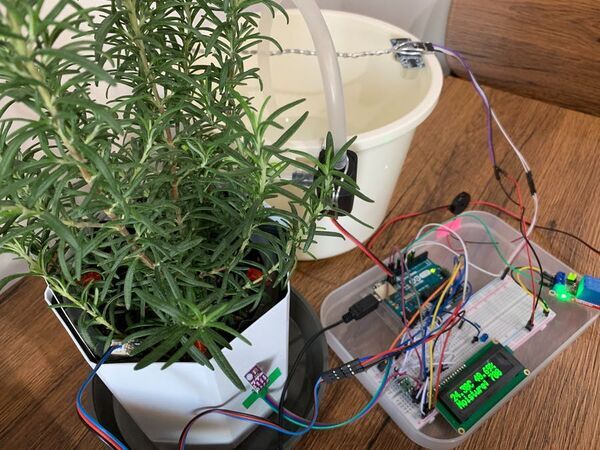
Automatic Watering System for My Plants
"When the soil is dry, Arduino will command the water pump to run. Our plant is absolutely cheerful anytime! This is my first project. I love plants, so I created an automatic watering system. Our system measures the soil moisture and waters automatically according to it. A blue LED tells us when the bucket is empty." [...]

Infrared Remote-Controlled AC Load ON/OFF switch with SSR
"Driving an AC high voltage and current load using an Infrared remote is very easy with this project. This is an open-source Arduino compatible hardware that is based on ATMEGA328 microcontroller, SSR (Solid-state Relay), Infrared Receiver TSOP1838, and analog input interface. We have used KSD215AC3 optically isolated solid-state relay to drive AC loads. We have tested this board with 200W/230V AC lamp, however, the load capacity of SSR is 15A. A snubber circuit is provided across the SSR-Triac which helps driving inductive loads. The heatsink on SSR is not required for loads up to 200W, however, for higher loads, it is advisable to mount SSR on a heatsink." [...]
That's all Folks!



